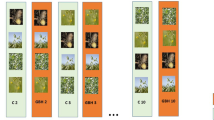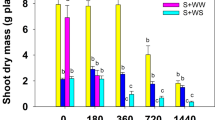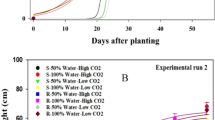Abstract
FIELD and greenhouse studies with a number of herbicides have demonstrated various degrees of growth inhibition of young gymnosperm seedlings. The effects vary greatly with the chemicals and dosage used, species, age of plants, manner of herbicide application, and environmental conditions1–4. Considerable work has been carried out on herbicidal influences on metabolism of herbaceous plants, but very little information is available for the responses of woody plants. Triazine herbicides are generally accepted as inhibitors of photosynthesis5,6. Metabolism is probably altered by atrazine in red kidney bean7 and by simazine in barley roots8. The extensive literature on 2,4-D and 2,4,5-T shows that metabolism varies greatly with species, age of plant, and tissues tested9–12. Ingle and Rogers13 have shown that dalapon may reduce phosphate uptake while it does not alter respiration materially. EPTC causes some increase in respiration of mung beans and corn embryos after relatively long exposure to the herbicide14. Experiments have now been extended to evaluate the short-time effects of the active and inert ingredients of commercial formulations of several herbicides on respiration of tissues of woody plants. Herbicides and corresponding commercial formulations were obtained as: 2,4-D (esteron 10-10), 2,4,5-T (esteron 2,4,5-OS), 2,4-DEP (falone 44-E), EPTC (‘Eptam 6 E’), CDEC (‘Vegadex’), CDAA (‘Randox’), simazine (simazine 50 W), atrazine (atrazine 50 W), ipazine (ipazine 25 E), prometone (prometone 25 E), dalapon (‘Dowpon’), and sesone (sesone).
This is a preview of subscription content, access via your institution
Access options
Subscribe to this journal
Receive 51 print issues and online access
$199.00 per year
only $3.90 per issue
Buy this article
- Purchase on Springer Link
- Instant access to full article PDF
Prices may be subject to local taxes which are calculated during checkout
Similar content being viewed by others
References
Kozlowski, T. T., and Kuntz, J. E., Soil Sci., 95, 164 (1963).
Winget, C. H., Kozlowski, T. T., and Kuntz, J. E., Weeds, 11, 87 (1963).
Kozlowski, T. T., Nature, 205, 104 (1965).
Sasaki, S., and Kozlowski, T. T., Univ. Wisconsin, Forestry Res. Note 105 (1963).
Gysin, H., Chem. and Indust., 1393 (1962).
Hilton, J. L., Jansen, L. L., and Hull, H. M., Ann. Revs. Plant. Physiol., 14, 353 (1963).
Ashton, F. M., and Uribe, E. G., Weeds, 10, 295 (1962).
Allen, S. W., and Palmer, R. D., Weeds, 11, 27 (1963).
Bourke, J. B., Fang, S. E., and Butts, J. S., Plant Physiol., 37, 233 (1962).
Dalrymple, A. V., and Basler, E., Weeds, 11, 41 (1963).
Kelly, S. M., and Avery, G. S., Amer. J. Bot., 36, 421 (1949).
Key, J. L., Hanson, J. B., and Bils, R. F., Plant Physiol., 35, 177 (1960).
Ingle, M., and Rogers, B. J., Weeds, 9, 264 (1960).
Ashton, F. M., Weeds, 11, 295 (1963).
Author information
Authors and Affiliations
Rights and permissions
About this article
Cite this article
SASAKI, S., KOZLOWSKI, T. Influence of Herbicides on Respiration of Young Pinus Seedlings. Nature 210, 439–440 (1966). https://doi.org/10.1038/210439a0
Issue Date:
DOI: https://doi.org/10.1038/210439a0
This article is cited by
-
Food relations of woody plants
The Botanical Review (1966)
Comments
By submitting a comment you agree to abide by our Terms and Community Guidelines. If you find something abusive or that does not comply with our terms or guidelines please flag it as inappropriate.



